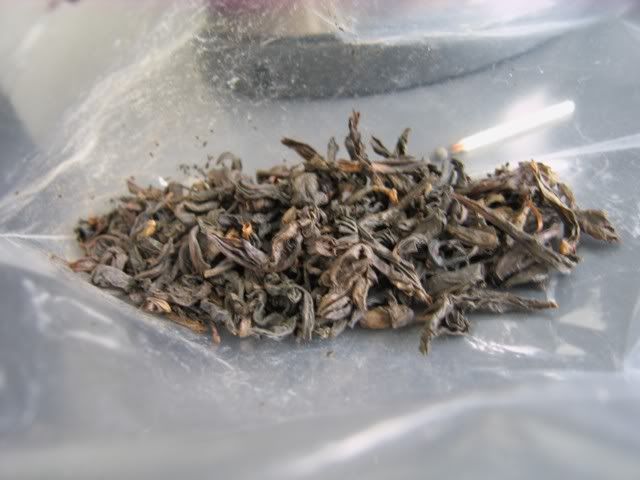More samples from Will.

Sample C, it says. Looks like dancong, smells like dancong, it’s probably a dancong, so I used my dancong pot.

Trying a new set up here, without using a tray and instead have a bowl to catch all the run off water with a wooden tray holding everything — which is just the bowl and the cup, as you can see here…

And then using a separate bowl to hold all the useless water (picture maybe tomorrow?). Maybe I can water plants with the run off tea.
How’s the tea though?
When I wrote to Will after drinking the tea, asking him what it is, I commented “seems rather bland — nothing too exciting”, and I think that basically captures what I think about the tea. It’s a dancong all right. Fragrant, not much bitterness unless you overbrew it (a plus), and overall decent, but it didn’t really stay in my mouth, nor did it give me a lingering sense of sweetness or throatiness. It’s basically a taste, and then it’s gone. That’s fine for a regular cup of tea, but I will get bored of such things quite quickly. It needed longish steeps quite soon to get more out of it, as I discovered. That’s fine, as it had a reasonable amount to give. That’s one good thing about this tea that’s obvious — it lasts quite a while and yields many steeps.

What surprised me was that this tea is one of the most expensive dancongs on offer at Tea Habitat at a whooping $75/oz. I was thinking to myself that this price seems rather high for not much tea, and not a terribly impressive one at that. Good teas cost money, there’s no doubt about that, but I also believe that truly good teas should not be too tempermental to make, as Will suggested this tea could be. I personally don’t really want to spend $25 or $50 just trying to figure out how to make this tea right. Per gram, it’s on par with some 20 years old puerh. For $75 I can buy half a kilo of some of my aged oolongs, and those are not tempermental to brew and fairly consistent. Half a kilo versus 28g…. I’m not sure if there’s much competition there.
I still remember going through my dancong phase once upon a time, early during the life of this blog actually. Then I quickly burned out, because after a while, they tend to taste sort of similar. I remember buying the second best dancong at the Best Tea House, and not the best one, because the best one cost double and the marginal difference between the two was slight. I think the same law should apply here — the marginal benefits of this tea is probably not enough to cover the marginal cost. Maybe there’s too much of the economist left in me, but as we all know, money talks.






















 RSS - Posts
RSS - Posts
I took you at your suggestion and have been reading some of your old post-Covid posts. I haven’t been to…